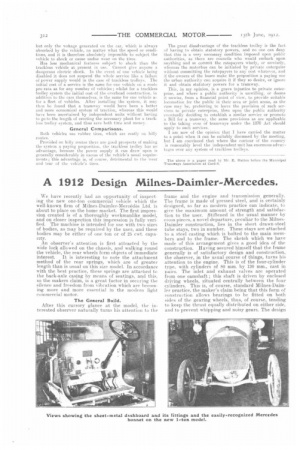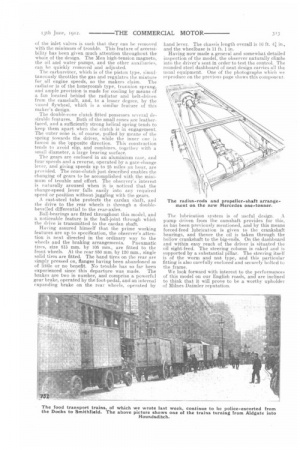A 1912 Design /Ailnes-Daimler-Mercedes.
Page 10

Page 11

If you've noticed an error in this article please click here to report it so we can fix it.
We have recently had an opportunity of inspect.. mg the new one-ton commercial vehicle which the well-known firm of Milnes-llaimler-Mercedes Ltd. is about to place on the home market. The first impression created is of a thoroughly workmanlike model, and on closer inspection this impression is fully verified. The machine is intended for use with two sizes of bodies, as may be required by the user, and these bodies may be either of one ton or of 25 cwt. capacity.
An observer's attention is first attracted by the wide lock allowed on the chassis, and walking round the vehicle, the rear wheels form objects of immediate interest. It is interesting to note the attachment method of the rear springs, which are of greater length than is usual on this size model. In accordance with the best practice, these springs are attached to the back-axle casing by means of seatings, and this, so the makers claim, is a great factor in securing the silence and freedom from vibration which are becoming more and more essential in the modern light eenamereial motor.
The General Build.
After this cursory glance at the model, the interested observer naturally turns his attention I o the
frame and the engine and transmission generally. The frame is made of pressed steel, and is certainly designed, so far as modern practice can indicate, to give the maximum amount. of strength and satisfaction to the user. Stiffened in the usual manner by cross pieces, a novel departure, peculiar to the MilnesDaimler construction, lies in the short drawn-steel tube stays, two in number. These stays are attached to a steel casting which is bolted to the main members and to the frame. The sketch which we have made of this arrangement gives a good idea of the construction. Having assured himself that the frame generally is of satisfactory design and construction, the observer, in the usual course of things, turns his attention to the engine. This is of the four-cylinder type, with cylinders of 80 ram. by 130 mm., cast in Pairs. The inlet and exhaust valves are operated from one camshaft ; this shaft is driven by enclosed driving wheels, situated centrally between the four cylinders. This is, of course, standard Milnes-Daimler practice, the maker's claim being that this form of construction allows bearings to be fitted on both sides of the gearing wheels, thus, of course, tending to keep the thrust equally distributed on either side, and to prevent whipping and noisy gears. The clesigm
of the inlet valves is such that they can be removed with the minimum of trouble. This feature of accessibility has been given much attention throughout the whole of the design. The Mea high-tension magneto, the oil and water pumps, and the other auxiliaries, can be quickly removed and adjusted. The carburetter, which is of the piston type, simultaneously throttles the gas and regulates the mixture for all engine speeds, so the makers claim. The radiator is of the honeycomb type, trunnion sprung, and ample. .provision is made for cooling by means of a fan located behind the radiator and belt-driven from the camshaft., and, to a lesser degree, by the vaned flywheel, which is a similar feature of this maker's design.
The double-cone, clutch fitted possesses several desirable features. Both of the small cones are leatherfaced, and a sufficiently strong helical spring tends to keep them apart when the clutch is in engagement. The outer cone is, of course, pulled by means of the spring towards the driver, while the inner uric is forced in the 'opposite direction. This construction tends to avoid slip, and combines, together with a small diameter, a large bearing surface.
The gears are enclosed in an aluminium case, and four speeds and a reverse, operated by a gate-change lever, and giving speeds up to 25 miles an hour, are provided. The cone-clutch just described enables the changing of gears to be accomplished with the minimum of trouble and effort. The observer's interest is naturally aroused when it is noticed that the change-speed lever falls easily into any required speed or position without juggling with the gears.
A east-steel tube protects the cardan shaft, and the drive to the rear wheels is through a doublebevelled differential to the rear-axles.
Ball-bearings are fitted throughout this model, and a noticeable feature is the ball-joint through which the drive is transmitted to the cardan shaft.
Having assured himself that the prime working features are up to specification, the observer's attention is next directed in the ordinary way to the wheels and the braking arrangements. Pneumatic tires, size 815 mm. by 105 mm,, are fitted to the front wheels. At the rear 850 nim. by 120 mm., single solid tires are fitted. The band tires on the rear are simply pressed on, flanges having been abandoned as of little or no benefit. No trouble has so far been experienced since' this departure was made. The brakes are two in number, and comprise a powerful gear brake, operated by the foot-pedal, and an internal expanding brake on the rear wheels, operated by hand lever. The chassis length overall is 16 ft. 41 in., and the wheelbase is 11 fa 1 in.
Having now made a general and somewhat detailed inspection of the model, the observer naturally climbs into the driver's seat in order to test the control. The rounded steel dashboard of neat design carries all the usual equipment. One of the photographs which we reproduce on the previous page shows this component..
The lubrication system is of useful design. A pump driven from the camshaft provides for this as has been previously mentioned, and by this means forced-feed lubrication is given to the crankshaft bearings, and thence the oil is taken through the hollow crankshaft to the big-ends. On the dashboard and within easy reach of the driver is situated the oil sight-feed. The steering column is raked and is supported by a substantial pillar. The steering itself is of the worm and nut type, and this particular fitting is also carefully enclosed and securely bolted to the frame.
We logk forward with interest to the and of this model on our English roads, and are inclined to think that it will prove to be a worthy upholder of Milnes-Daimler reputation.
























